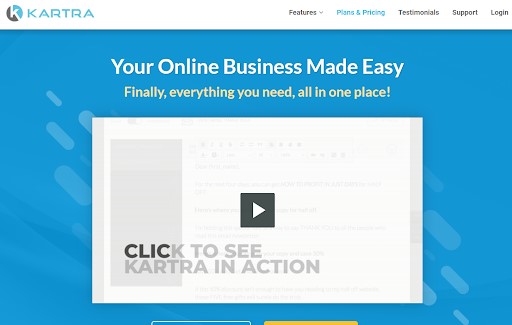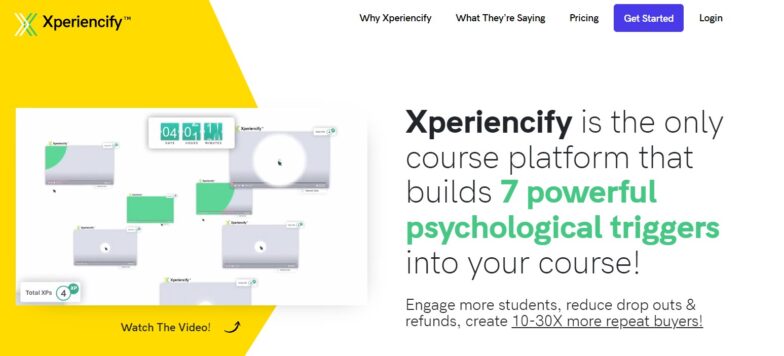9+ Thinkific Alternatives to Jump-Start Your Course (2022)
Greg Webster
If you’ve ever struggled to learn an online course platform, you’re far from alone.
The truth is, many course creators face challenges when it comes to navigating a new course platform.
But the good news is there are plenty of user-friendly options that make it simple to get your course online.
Thinkific is one platform that’s very popular among new course creators, but there are also many Thinkific alternatives for you to consider. To help you zero in on the right platform for your course, we’ve reviewed 10 Thinkific competitors and uncovered the pros and cons of each.
But first, let’s take a quick look at Thinkific so you’ll know what you’re comparing the others to.
What Are the Pros and Cons of Thinkific?
The Thinkific platform is powerful and has recently introduced helpful changes in pricing. The Free Starter plan once charged a 10% cut of course profits but no longer does. Thinkific has also introduced Pro+ Growth that allows incremental upgrades to the top level.

These are the four plans (or five, if you consider Pro+Growth a separate level):
- Free: With no transaction fee.
- Basic: Paid at $49/month for a total cost of $588/year. Paid annually is $468.
- Pro: Paid at $99/month for a total cost of $1,188/year. Paid annually is $948. (When enrolled in Pro, you are also eligible for Pro+ Growth upgrades.)
- Premier: Paid at $499/month for a total cost of $5,988/year. Paid annually is $4,788/year.
Now lets take a look at the main pros and cons of Thinkific:
Pros
- A robust assortment of marketing features, including email integration and affiliate connections for all but the Free plan.
- Comprehensive video and content hosting for all plans.
- Live lesson options for all but the bottom two plans.
Cons
- Offers drip or scheduled content delivery only on paid plans.
- Doesn’t provide completion certificates on the Free and Basic plans.
- In Free and Basic plans, doesn’t require students to complete video lessons before continuing.
- Leaves Thinkific branding in some place except in the top two plans.
The Best Thinkific Alternatives for Your Online Course
Now, let’s turn our attention to some of the best Thinkific alternatives.
Since all but three of the course platforms below claim some form of “all-in-one” or we supply “everything you need” offering, we’ll dig for more definitive distinctions. I’ll talk about the exceptions when we get there.
1. Podia
In addition to hosting online courses, Podia sets you up to sell digital downloads like eBooks, audiobooks, and course supplements (such as checklists and “cheat” sheets). You can also expand your teaching to include one-on-one live coaching, webinars, and online communities for member discussions.
This Thinkific alternative offers a 14-day free trial of any of these plans:
- Mover: Paid at $39/month for a total cost of $468/year. Paid annually is $390.
- Shaker: Paid at $79/month for a total cost of $948/year. Paid annually is $790.
- Earthquaker: Paid at $179/month for a total cost of $2,148/year. Paid annually is $1,790/year.
Now, for a few Pros and Cons.
Pros
- No transaction fees for selling in any of the three plans.
- Solid platform for membership community on all levels.
- Webinars and live Q&As available on all plans.
Cons
- Monthly email recipient limits require additional payments to increase.
- Podia branding removed from your site only on top two plans.
- Coaching and affiliate marketing not available on low-end plan.
2. Teachable
Teachable is a platform that emphasizes user customization. Course set-up allows you, the teacher, to create the look, style, and self-branding that you want.

Teachable offers four levels, including a Free plan.
- Free: Assesses a fee of $1.00 plus 10% per transaction.
- Basic: Paid annually is $348 (quoted at $29/month but no monthly pay option available). Also assesses a fee of 5% per transaction.
- Pro: Paid annually is $1,188 (quoted at $99/month but no monthly pay option available).
- Business: Paid annually is $2,988 (quoted at $249/month but no monthly pay option available).
Pros
- Unlimited products and students on all plans.
- Offers a Free plan.
- Allows video components in courses on all plans with unlimited bandwidth.
Cons
- Offers drip or scheduled content delivery only on paid plans.
- Live chat feature available only on top two plans.
- Affiliate program, graded quizzes, and course completion certificates available only on top two plans.
- No monthly pay option available.
3. LearnDash
LearnDash avoids the all-in-one claim. Instead, it promotes integration with WordPress. Since this Thinkific alternative is the only LMS specifically designed to work with WordPress, if you use and like WP, this may be just the one for you.
LearnDash offers three levels but no free plan.
- Basic: Paid annually is $199 (no monthly pay option).
- Plus Package: Paid annually is $229 (no monthly pay option).
- Pro Package: Paid annually is $369 (no monthly pay option).
Pros
- Unlimited courses and students on all plans.
- Drip-feed course content available on all plans.
- Quizzing and course completion certificates offered on all plans.
Cons
- Provides (free) email marketing integration, but it must be added as a plugin.
- LearnDash itself is a WordPress plugin so is designed to work primarily with WordPress sites.
- Live webinar and conference capability is not built in and can only be included through add-ons suggested by LearnDash.
4. Kajabi
Kajabi is a robust platform that may well do the best job of any course platform of delivering on the everything-you-need/all-in-one claim. But it comes with a price.

Kajabi offers three levels, each of which offers a 14-day free trial.
- Basic: Paid at $149/month for a total cost of $1,788/year. Paid annually is $1,428.
- Growth: Paid at $199/month for a total cost of $2,388/year. Paid annually is $1,908.
- Pro: Paid at $399/month for a total cost of $4,788/year. Paid annually is $3,720/year.
Pros
- Offers unlimited marketing emails on all plans.
- Provides webinar, live events, and coaching options on all plans.
- Integrates podcasting capability with teaching tools.
Cons
- No lost-cost option for entry.
- Affiliate program not available on Basic plan.
- Kajabi branding can’t be removed from the Basic plan (despite the price!).
If you want to learn more about Kajabi and how it compares with Thinkific, click here.
5. LearnWorlds
LearnWorlds avoids the all-in-one claim but actually does provide it. They’re simply better at not sounding like everyone else.
LearnWorlds provides the necessary array of course creation services and sets up a marketing program that includes cross-selling, click-funnels, and special offers.
This Thinkific competitor offers four plans, the first three of which provide a 30-day free trial.
- Starter: Paid at $29/month for a total cost of $348/year. Paid annually is $288. Starter plan assesses a $5.00/course transaction fee.
- Pro Trainer: Paid at $99/month for a total cost of $1,188/year. Paid annually is $948.
- Learning Center: Paid at $299/month for a total cost of $3,588/year. Paid annually is $2,988/year.
- High Volume and Corporate: Must contact LearnWorlds for pricing.
Pros
- Video feature includes options like automatically generated interactive transcripts.
- Unlimited paid courses on all plans.
- Drip-feed courses on all plans.
Cons
- Starter plan assesses a transaction fee.
- Live classes and webinars not available on Starter plan.
- Free courses not available on Starter plan.
6. Kartra

Kartra promotes robust seamlessness for all functions of online teaching:
If someone lands on your Kartra page, Kartra Analytics tracks it. If a user fills in a form, Kartra Mail subscribes him/her to your newsletter. Or if a customer pays through Kartra checkout, Kartra Memberships send out login credentials.
Kartra offers four levels, the first three of which provide a 30-day free trial.
- Starter: Paid at $99/month for a total cost of $1,188/year. Paid annually is $948.
- Silver: Paid at $199/month for a total cost of $2,388/year. Paid annually is $1,788.
- Gold: Paid at $299/month for a total cost of $3,588/year. Paid annually is $2,748/year.
- Platinum: Paid at $499/month for a total cost of $5,988/year. Paid annually is $4,548/year.
Pros
- Unlimited emails, videos, and products on top three plans.
- Top three plans include “Kartra Agency” so you can manage Kartra for others ($$!) while selling your own courses.
- Most consistent across the levels of any LMS in this list.
Cons
- Must start with Silver if you need more than one domain name.
- No free plan available.
7. Mighty Networks
Mighty Networks emphasizes its community capabilities, possibly at the expense of other features.
In terms of pricing, Mighty Networks offers three levels.
- Community Plan: Paid at $28/month for a total cost of $336/year. Paid annually is $276.
- Business Plan: Paid at $98/month for a total cost of $1,176/year. Paid annually is $972.
- Mighty Pro: You must contact Mighty Networks for pricing.
Pros
- All plans offer unlimited members, admins, and moderators.
- Top plan has a relatively low price compared to other top plans.
- Offers SEO assistance on all plans.
Cons
- Limited video options with the Community plan.
- Drip lessons available only with the Business plan.
- Assesses a 3% member subscription fee on Community and 2% on Business.
8. iSpring
iSpring Market avoids the all-in-one claim, but its wide-ranging features are reflected in a wearisome pricing structure.

Two “suites” are based on the number of authors using the program.
- iSpring Suite: Annual cost for one author is $770 with options to upgrade to 3 or 5 for a lower cost/author. (No monthly billing and Custom upgrades are available by contacting iSpring.)
- iSpring Suite Max: Annual cost for one author is $970 with options to upgrade to 3 or 5. Because Max options are more robust, incremental costs are larger than Suite. (No monthly billing and Custom upgrades available.)
This two-point summary does not adequately explain the add-on costs (some significant), so you should evaluate this pricing page for yourself: iSpring Pricing
Pros
- No transaction fees.
- Offers free “Fast eLearning authoring toolkit.”
- Provides free trials for add-ons once you’re using iSpring.
Cons
- Complex pricing.
- Limitations on number of authors in program.
9. Ruzuku
In addition to all-in-one offerings, Ruzuku recognizes the importance of email integration and robust video in all of its plans.
This Thinkific alternative offers three levels.
- Bootstrapper: Paid at $99/month for a total cost of $1,188/year. Paid annually is $879.
- Up-and-Comer: Paid at $149/month for a total cost of $1,788/year. Paid annually is $996.96.
- University: Paid at $199/month for a total cost of $2,388/year. Paid annually is $1,500.
Pros
- Unlimited courses and students on all plans
- Offers unlimited video, audio, and data hosting on all plans.
- No transaction fees.
Cons
- Only the University plan allows more than one instructor.
- No free plan but 14-day free trial offered on all plans.
- Bootstrapper does not offer subscriptions or payment plans.
10. Xperiencify
Xperiencify is the final course platform in our group and is another one that doesn’t highlight some version of the all-in-one claim. Instead, it offers an intriguing twist in its concept of automatically embedding “7 powerful psychological triggers into your courses.”

Xperiencify offers three levels.
- Launch: Paid at $49/month for a total cost of $588/year. Paid annually is $504.
- Growth: Paid at $149/month for a total cost of $1,788/year. Paid annually is $1,404.
- Scale: Paid at $499/month for a total cost of $5,988/year. Paid annually is $4,500.
Pros
- You’re not required to pay until you publish your first course.
- Unlimited courses and students allowed on all plans.
- Drip content available on all plans.
Cons
- Larger than usual jump in price between top two plans.
- Transaction fee of 4.9% in Launch plan.
- No custom domain or email sending available in the Launch plan.
Choosing the Best Thinkific Alternative for You
If you’re not a techno-geek, Thinkific competitors offering good hand-holding would be the choice for you. The only selection above that comes close to being a “no-brainer” is LearnDash, if you love WordPress.
Before making a choice, you’ll need to know your budget and if you can jump right in with a paid plan. If you’re already an experienced course creator, you’ll probably be able to start with more robust and costly options.
To make sure you find the right online course platform, we recommend you dive a little deeper and study the websites of each Thinkific competitor.
Once you’re familiar with what each platform offers, you can decide which one is right for you.
Now go forth and find your perfect course platform!
Want to learn more about the online course creation process? We invite you to enroll in our Free Hybrid Courses Bootcamp so you can set yourself up for long-term success.
Let’s Start Building Your Online Course!
In our FREE Hybrid Courses Bootcamp, we’ll walk you through how to transform your knowledge and expertise into a profitable online course… one your students will love.